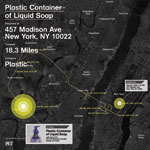
What if we understood where trash went, and how much energy it took to make it disappear? Would consumers think twice about their purchases? Would the industry redesign its products? Would municipalities reshape their trash removal infrastructures? Those are the questions guiding a team of MIT researchers in a project called Trash Track, which uses thousands of wireless electronic tags to monitor waste on its journey through the disposal systems of New York and Seattle. Preliminary data, including the migration patterns of a disposed coffee cup and yogurt container, were on view at the Architectural League in New York City and in the Seattle Public Library last fall. (Trash Track, MIT SENSEable City lab,http://senseable.mit.edu/trashtrack/)
